Perspectives In Criminology Assignment 2022
VerifiedAdded on 2022/09/16
|14
|3450
|13
Assignment
AI Summary
Contribute Materials
Your contribution can guide someone’s learning journey. Share your
documents today.
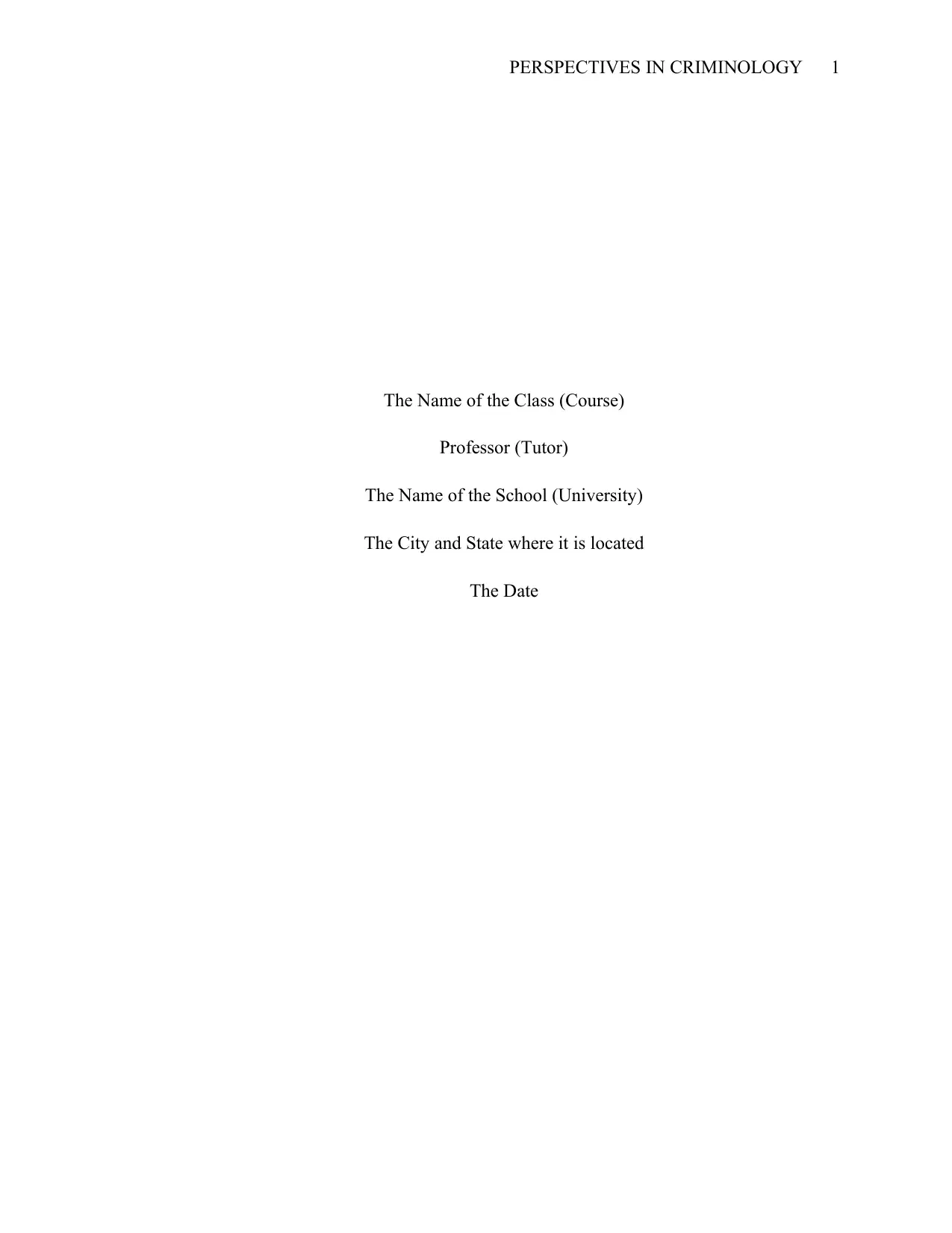
PERSPECTIVES IN CRIMINOLOGY 1
The Name of the Class (Course)
Professor (Tutor)
The Name of the School (University)
The City and State where it is located
The Date
The Name of the Class (Course)
Professor (Tutor)
The Name of the School (University)
The City and State where it is located
The Date
Secure Best Marks with AI Grader
Need help grading? Try our AI Grader for instant feedback on your assignments.
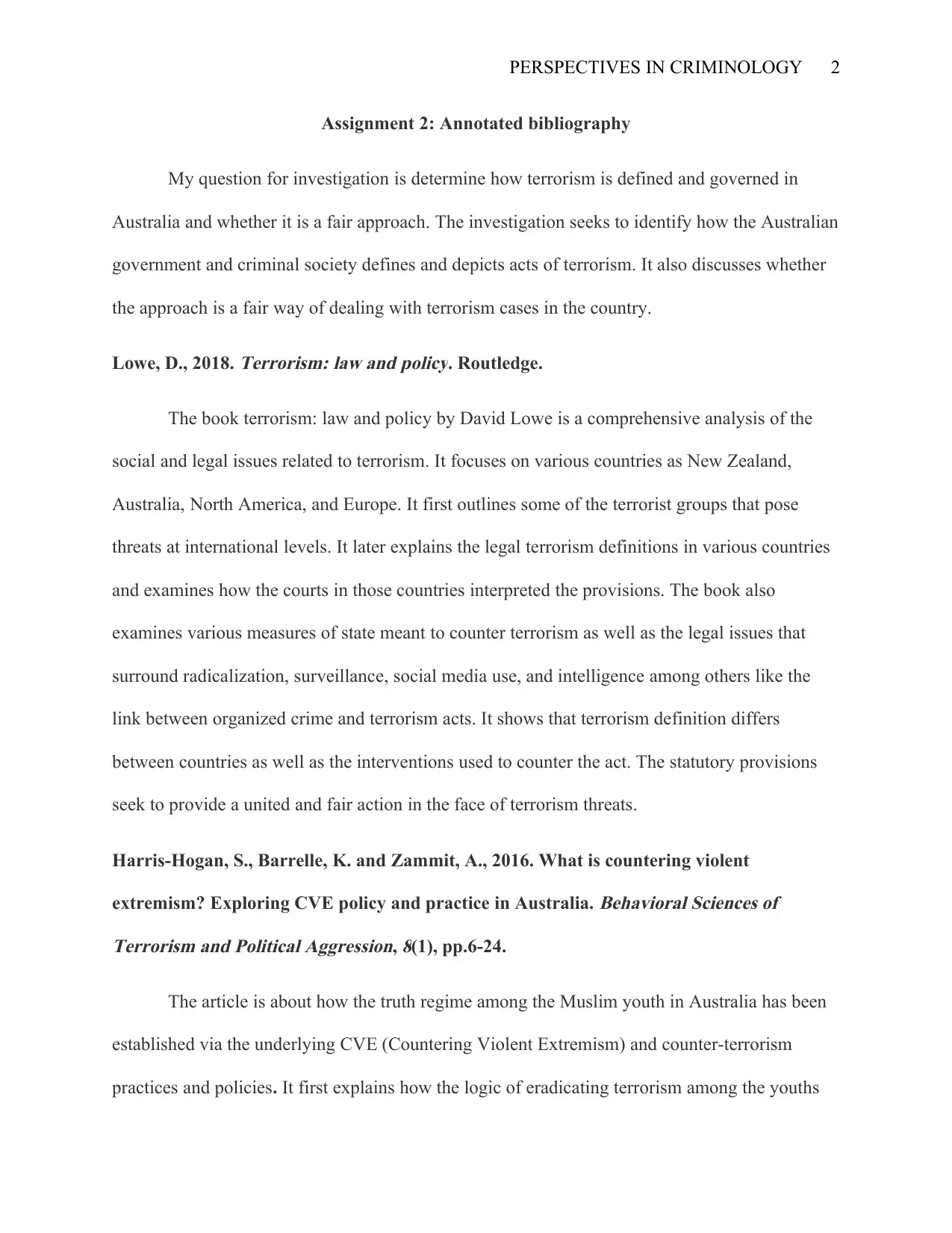
PERSPECTIVES IN CRIMINOLOGY 2
Assignment 2: Annotated bibliography
My question for investigation is determine how terrorism is defined and governed in
Australia and whether it is a fair approach. The investigation seeks to identify how the Australian
government and criminal society defines and depicts acts of terrorism. It also discusses whether
the approach is a fair way of dealing with terrorism cases in the country.
Lowe, D., 2018.
Terrorism: law and policy. Routledge.
The book terrorism: law and policy by David Lowe is a comprehensive analysis of the
social and legal issues related to terrorism. It focuses on various countries as New Zealand,
Australia, North America, and Europe. It first outlines some of the terrorist groups that pose
threats at international levels. It later explains the legal terrorism definitions in various countries
and examines how the courts in those countries interpreted the provisions. The book also
examines various measures of state meant to counter terrorism as well as the legal issues that
surround radicalization, surveillance, social media use, and intelligence among others like the
link between organized crime and terrorism acts. It shows that terrorism definition differs
between countries as well as the interventions used to counter the act. The statutory provisions
seek to provide a united and fair action in the face of terrorism threats.
Harris-Hogan, S., Barrelle, K. and Zammit, A., 2016. What is countering violent
extremism? Exploring CVE policy and practice in Australia.
Behavioral Sciences of
Terrorism and Political Aggression,
8(1), pp.6-24.
The article is about how the truth regime among the Muslim youth in Australia has been
established via the underlying CVE (Countering Violent Extremism) and counter-terrorism
practices and policies. It first explains how the logic of eradicating terrorism among the youths
Assignment 2: Annotated bibliography
My question for investigation is determine how terrorism is defined and governed in
Australia and whether it is a fair approach. The investigation seeks to identify how the Australian
government and criminal society defines and depicts acts of terrorism. It also discusses whether
the approach is a fair way of dealing with terrorism cases in the country.
Lowe, D., 2018.
Terrorism: law and policy. Routledge.
The book terrorism: law and policy by David Lowe is a comprehensive analysis of the
social and legal issues related to terrorism. It focuses on various countries as New Zealand,
Australia, North America, and Europe. It first outlines some of the terrorist groups that pose
threats at international levels. It later explains the legal terrorism definitions in various countries
and examines how the courts in those countries interpreted the provisions. The book also
examines various measures of state meant to counter terrorism as well as the legal issues that
surround radicalization, surveillance, social media use, and intelligence among others like the
link between organized crime and terrorism acts. It shows that terrorism definition differs
between countries as well as the interventions used to counter the act. The statutory provisions
seek to provide a united and fair action in the face of terrorism threats.
Harris-Hogan, S., Barrelle, K. and Zammit, A., 2016. What is countering violent
extremism? Exploring CVE policy and practice in Australia.
Behavioral Sciences of
Terrorism and Political Aggression,
8(1), pp.6-24.
The article is about how the truth regime among the Muslim youth in Australia has been
established via the underlying CVE (Countering Violent Extremism) and counter-terrorism
practices and policies. It first explains how the logic of eradicating terrorism among the youths
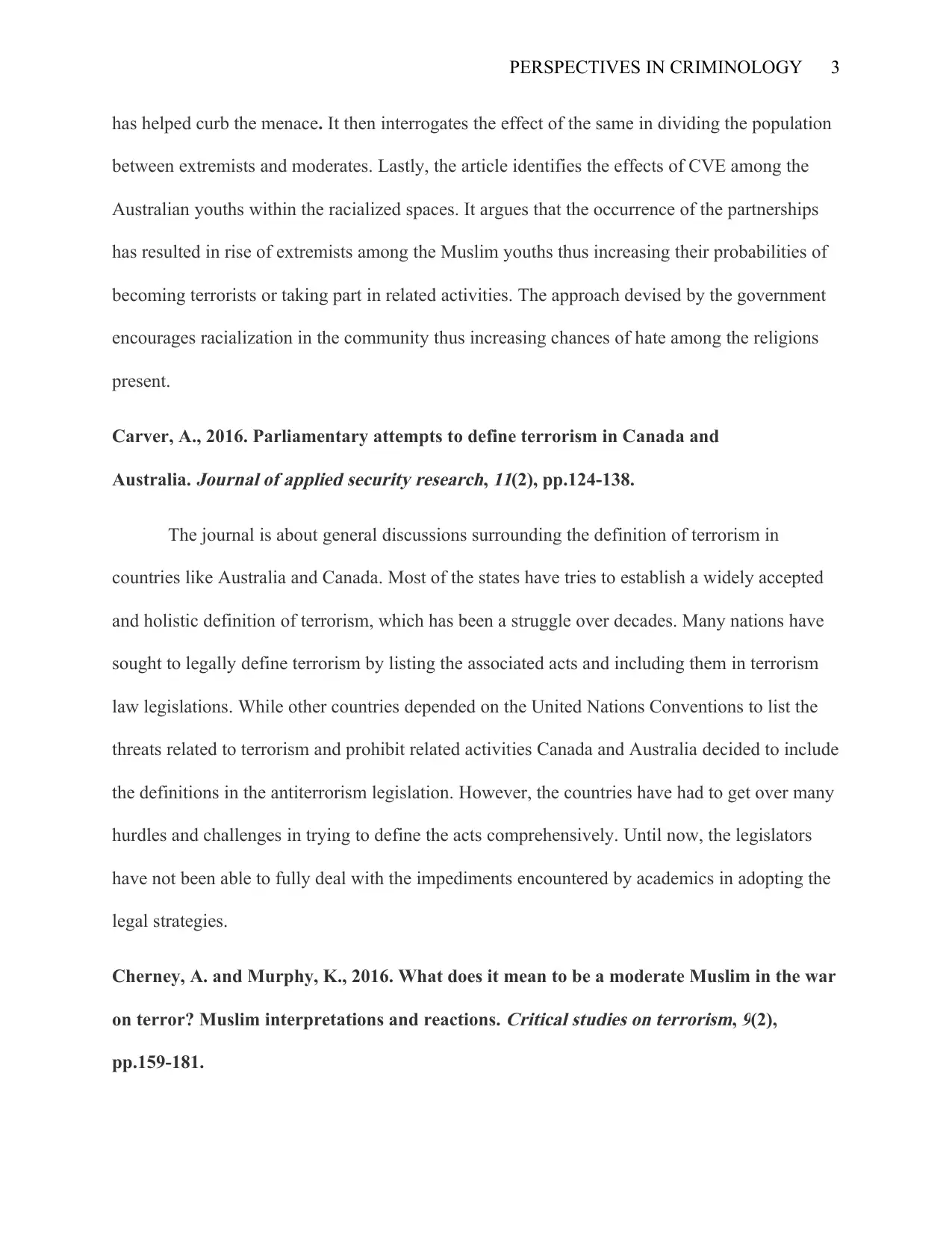
PERSPECTIVES IN CRIMINOLOGY 3
has helped curb the menace. It then interrogates the effect of the same in dividing the population
between extremists and moderates. Lastly, the article identifies the effects of CVE among the
Australian youths within the racialized spaces. It argues that the occurrence of the partnerships
has resulted in rise of extremists among the Muslim youths thus increasing their probabilities of
becoming terrorists or taking part in related activities. The approach devised by the government
encourages racialization in the community thus increasing chances of hate among the religions
present.
Carver, A., 2016. Parliamentary attempts to define terrorism in Canada and
Australia.
Journal of applied security research,
11(2), pp.124-138.
The journal is about general discussions surrounding the definition of terrorism in
countries like Australia and Canada. Most of the states have tries to establish a widely accepted
and holistic definition of terrorism, which has been a struggle over decades. Many nations have
sought to legally define terrorism by listing the associated acts and including them in terrorism
law legislations. While other countries depended on the United Nations Conventions to list the
threats related to terrorism and prohibit related activities Canada and Australia decided to include
the definitions in the antiterrorism legislation. However, the countries have had to get over many
hurdles and challenges in trying to define the acts comprehensively. Until now, the legislators
have not been able to fully deal with the impediments encountered by academics in adopting the
legal strategies.
Cherney, A. and Murphy, K., 2016. What does it mean to be a moderate Muslim in the war
on terror? Muslim interpretations and reactions.
Critical studies on terrorism,
9(2),
pp.159-181.
has helped curb the menace. It then interrogates the effect of the same in dividing the population
between extremists and moderates. Lastly, the article identifies the effects of CVE among the
Australian youths within the racialized spaces. It argues that the occurrence of the partnerships
has resulted in rise of extremists among the Muslim youths thus increasing their probabilities of
becoming terrorists or taking part in related activities. The approach devised by the government
encourages racialization in the community thus increasing chances of hate among the religions
present.
Carver, A., 2016. Parliamentary attempts to define terrorism in Canada and
Australia.
Journal of applied security research,
11(2), pp.124-138.
The journal is about general discussions surrounding the definition of terrorism in
countries like Australia and Canada. Most of the states have tries to establish a widely accepted
and holistic definition of terrorism, which has been a struggle over decades. Many nations have
sought to legally define terrorism by listing the associated acts and including them in terrorism
law legislations. While other countries depended on the United Nations Conventions to list the
threats related to terrorism and prohibit related activities Canada and Australia decided to include
the definitions in the antiterrorism legislation. However, the countries have had to get over many
hurdles and challenges in trying to define the acts comprehensively. Until now, the legislators
have not been able to fully deal with the impediments encountered by academics in adopting the
legal strategies.
Cherney, A. and Murphy, K., 2016. What does it mean to be a moderate Muslim in the war
on terror? Muslim interpretations and reactions.
Critical studies on terrorism,
9(2),
pp.159-181.
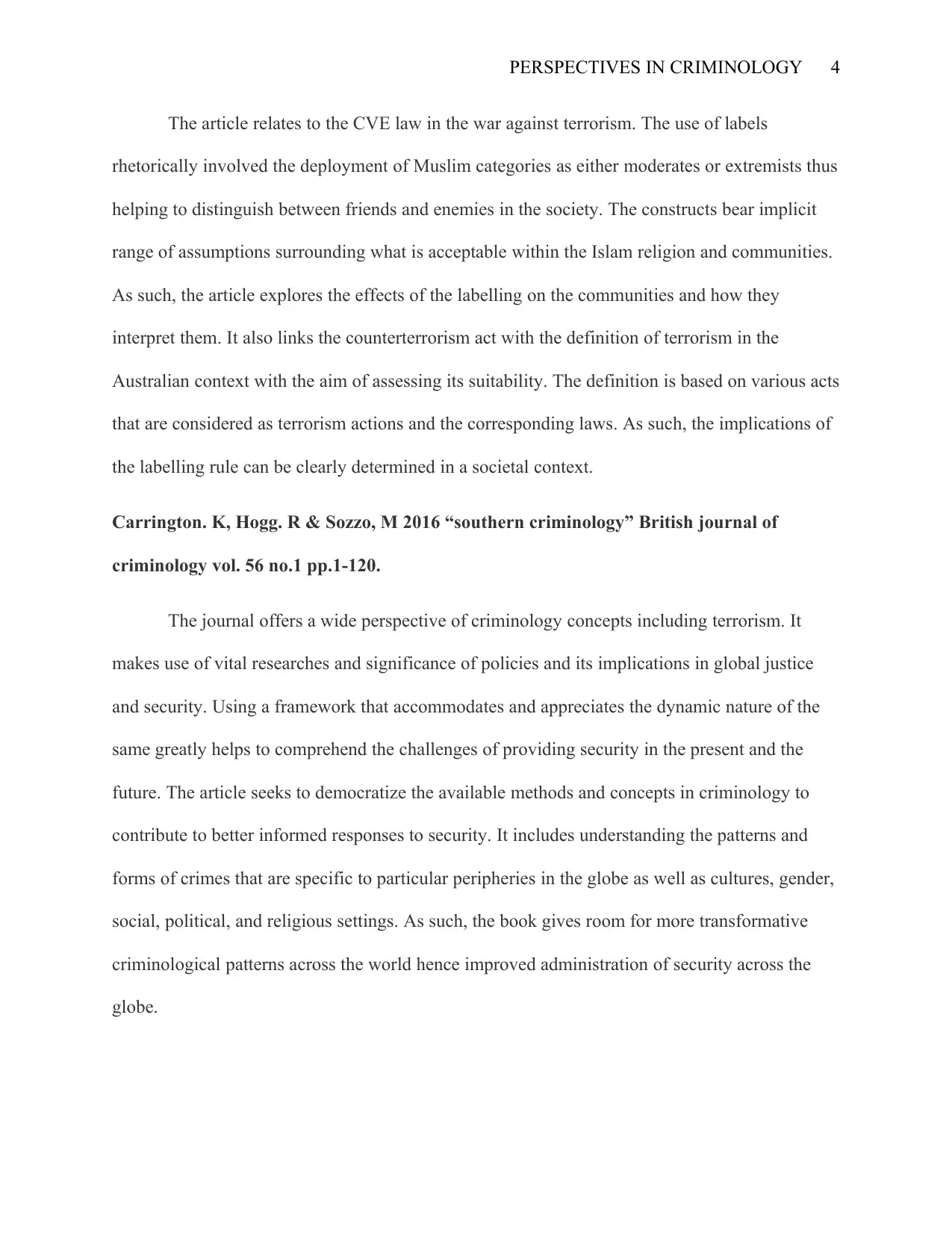
PERSPECTIVES IN CRIMINOLOGY 4
The article relates to the CVE law in the war against terrorism. The use of labels
rhetorically involved the deployment of Muslim categories as either moderates or extremists thus
helping to distinguish between friends and enemies in the society. The constructs bear implicit
range of assumptions surrounding what is acceptable within the Islam religion and communities.
As such, the article explores the effects of the labelling on the communities and how they
interpret them. It also links the counterterrorism act with the definition of terrorism in the
Australian context with the aim of assessing its suitability. The definition is based on various acts
that are considered as terrorism actions and the corresponding laws. As such, the implications of
the labelling rule can be clearly determined in a societal context.
Carrington. K, Hogg. R & Sozzo, M 2016 “southern criminology” British journal of
criminology vol. 56 no.1 pp.1-120.
The journal offers a wide perspective of criminology concepts including terrorism. It
makes use of vital researches and significance of policies and its implications in global justice
and security. Using a framework that accommodates and appreciates the dynamic nature of the
same greatly helps to comprehend the challenges of providing security in the present and the
future. The article seeks to democratize the available methods and concepts in criminology to
contribute to better informed responses to security. It includes understanding the patterns and
forms of crimes that are specific to particular peripheries in the globe as well as cultures, gender,
social, political, and religious settings. As such, the book gives room for more transformative
criminological patterns across the world hence improved administration of security across the
globe.
The article relates to the CVE law in the war against terrorism. The use of labels
rhetorically involved the deployment of Muslim categories as either moderates or extremists thus
helping to distinguish between friends and enemies in the society. The constructs bear implicit
range of assumptions surrounding what is acceptable within the Islam religion and communities.
As such, the article explores the effects of the labelling on the communities and how they
interpret them. It also links the counterterrorism act with the definition of terrorism in the
Australian context with the aim of assessing its suitability. The definition is based on various acts
that are considered as terrorism actions and the corresponding laws. As such, the implications of
the labelling rule can be clearly determined in a societal context.
Carrington. K, Hogg. R & Sozzo, M 2016 “southern criminology” British journal of
criminology vol. 56 no.1 pp.1-120.
The journal offers a wide perspective of criminology concepts including terrorism. It
makes use of vital researches and significance of policies and its implications in global justice
and security. Using a framework that accommodates and appreciates the dynamic nature of the
same greatly helps to comprehend the challenges of providing security in the present and the
future. The article seeks to democratize the available methods and concepts in criminology to
contribute to better informed responses to security. It includes understanding the patterns and
forms of crimes that are specific to particular peripheries in the globe as well as cultures, gender,
social, political, and religious settings. As such, the book gives room for more transformative
criminological patterns across the world hence improved administration of security across the
globe.
Secure Best Marks with AI Grader
Need help grading? Try our AI Grader for instant feedback on your assignments.
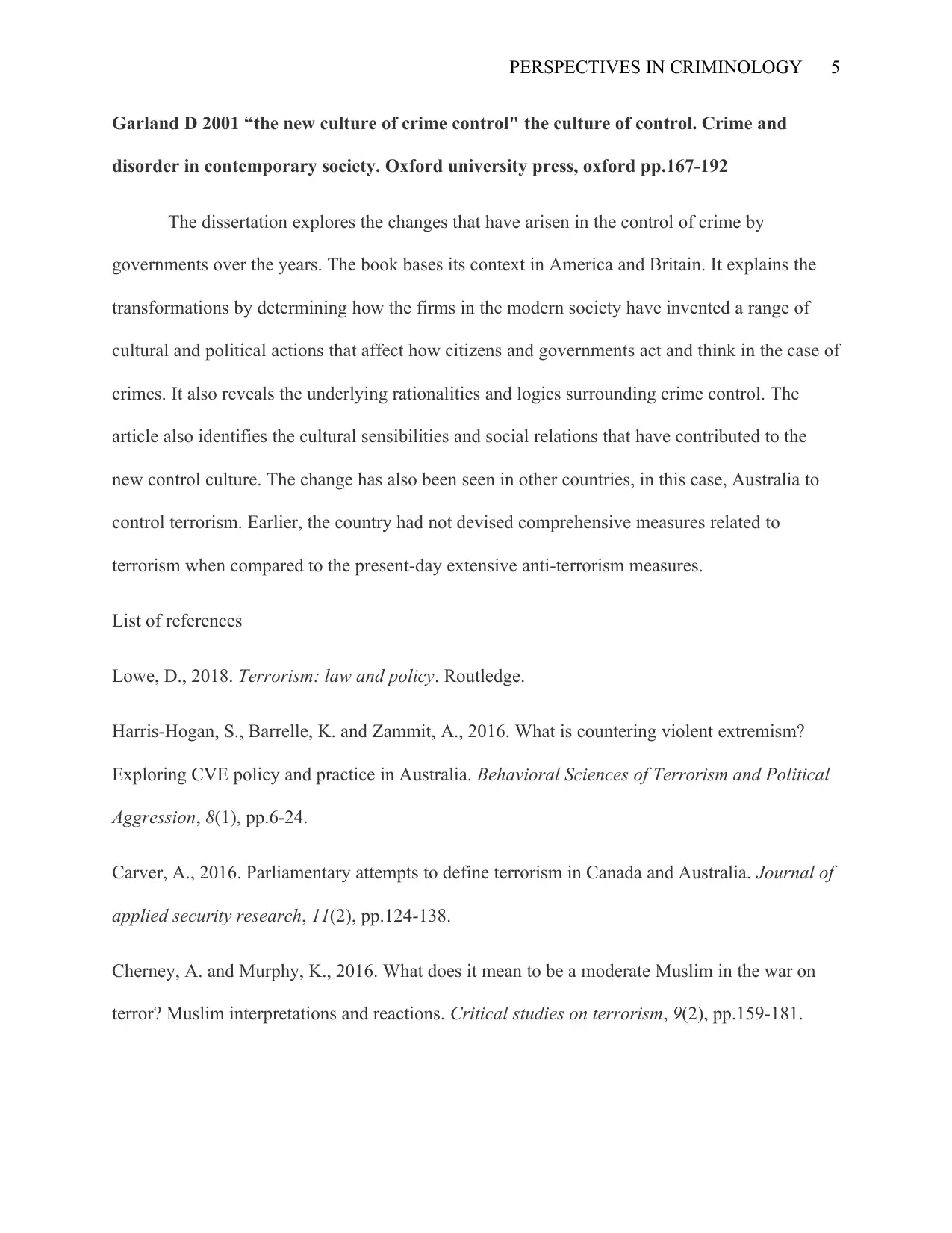
PERSPECTIVES IN CRIMINOLOGY 5
Garland D 2001 “the new culture of crime control" the culture of control. Crime and
disorder in contemporary society. Oxford university press, oxford pp.167-192
The dissertation explores the changes that have arisen in the control of crime by
governments over the years. The book bases its context in America and Britain. It explains the
transformations by determining how the firms in the modern society have invented a range of
cultural and political actions that affect how citizens and governments act and think in the case of
crimes. It also reveals the underlying rationalities and logics surrounding crime control. The
article also identifies the cultural sensibilities and social relations that have contributed to the
new control culture. The change has also been seen in other countries, in this case, Australia to
control terrorism. Earlier, the country had not devised comprehensive measures related to
terrorism when compared to the present-day extensive anti-terrorism measures.
List of references
Lowe, D., 2018. Terrorism: law and policy. Routledge.
Harris-Hogan, S., Barrelle, K. and Zammit, A., 2016. What is countering violent extremism?
Exploring CVE policy and practice in Australia. Behavioral Sciences of Terrorism and Political
Aggression, 8(1), pp.6-24.
Carver, A., 2016. Parliamentary attempts to define terrorism in Canada and Australia. Journal of
applied security research, 11(2), pp.124-138.
Cherney, A. and Murphy, K., 2016. What does it mean to be a moderate Muslim in the war on
terror? Muslim interpretations and reactions. Critical studies on terrorism, 9(2), pp.159-181.
Garland D 2001 “the new culture of crime control" the culture of control. Crime and
disorder in contemporary society. Oxford university press, oxford pp.167-192
The dissertation explores the changes that have arisen in the control of crime by
governments over the years. The book bases its context in America and Britain. It explains the
transformations by determining how the firms in the modern society have invented a range of
cultural and political actions that affect how citizens and governments act and think in the case of
crimes. It also reveals the underlying rationalities and logics surrounding crime control. The
article also identifies the cultural sensibilities and social relations that have contributed to the
new control culture. The change has also been seen in other countries, in this case, Australia to
control terrorism. Earlier, the country had not devised comprehensive measures related to
terrorism when compared to the present-day extensive anti-terrorism measures.
List of references
Lowe, D., 2018. Terrorism: law and policy. Routledge.
Harris-Hogan, S., Barrelle, K. and Zammit, A., 2016. What is countering violent extremism?
Exploring CVE policy and practice in Australia. Behavioral Sciences of Terrorism and Political
Aggression, 8(1), pp.6-24.
Carver, A., 2016. Parliamentary attempts to define terrorism in Canada and Australia. Journal of
applied security research, 11(2), pp.124-138.
Cherney, A. and Murphy, K., 2016. What does it mean to be a moderate Muslim in the war on
terror? Muslim interpretations and reactions. Critical studies on terrorism, 9(2), pp.159-181.
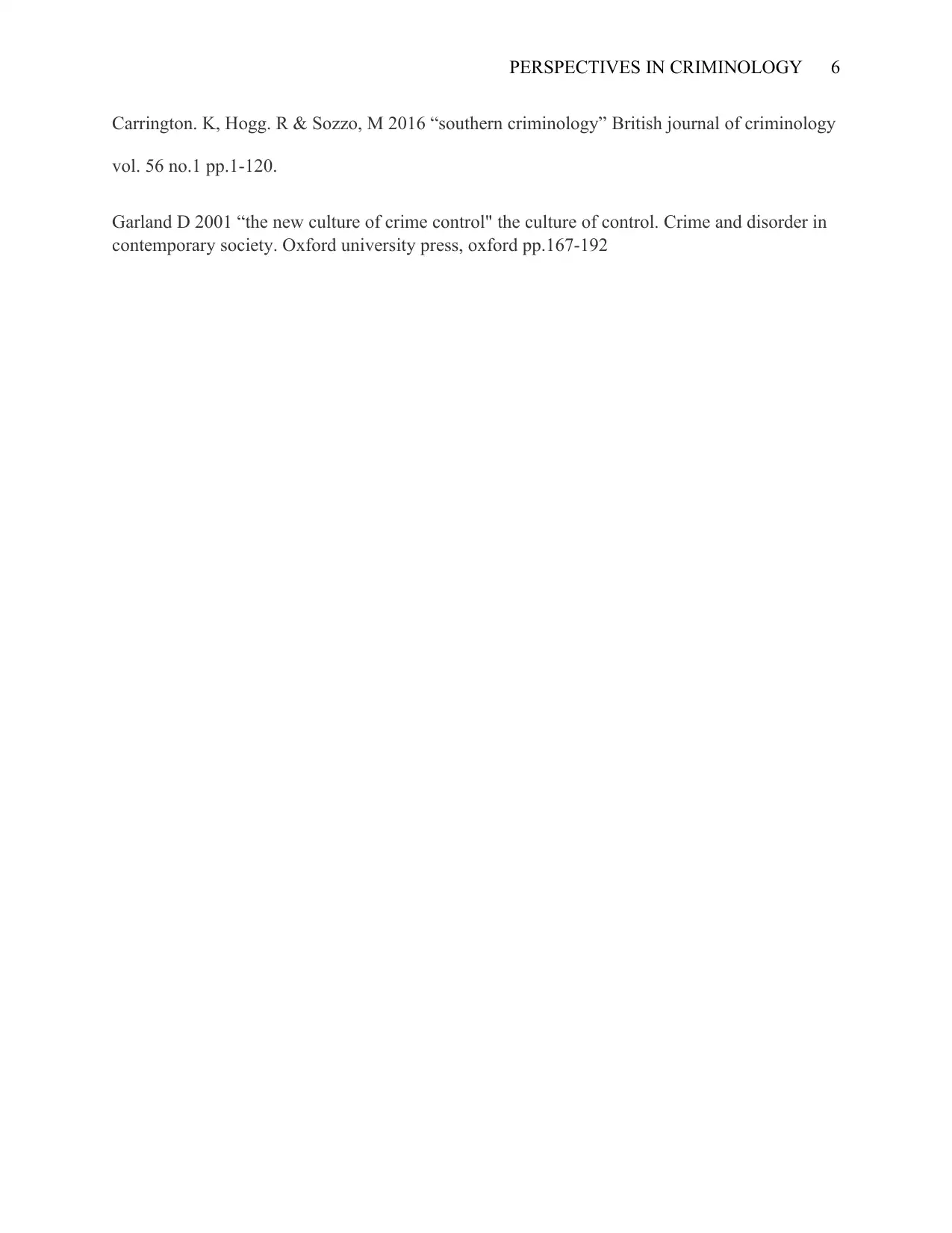
PERSPECTIVES IN CRIMINOLOGY 6
Carrington. K, Hogg. R & Sozzo, M 2016 “southern criminology” British journal of criminology
vol. 56 no.1 pp.1-120.
Garland D 2001 “the new culture of crime control" the culture of control. Crime and disorder in
contemporary society. Oxford university press, oxford pp.167-192
Carrington. K, Hogg. R & Sozzo, M 2016 “southern criminology” British journal of criminology
vol. 56 no.1 pp.1-120.
Garland D 2001 “the new culture of crime control" the culture of control. Crime and disorder in
contemporary society. Oxford university press, oxford pp.167-192
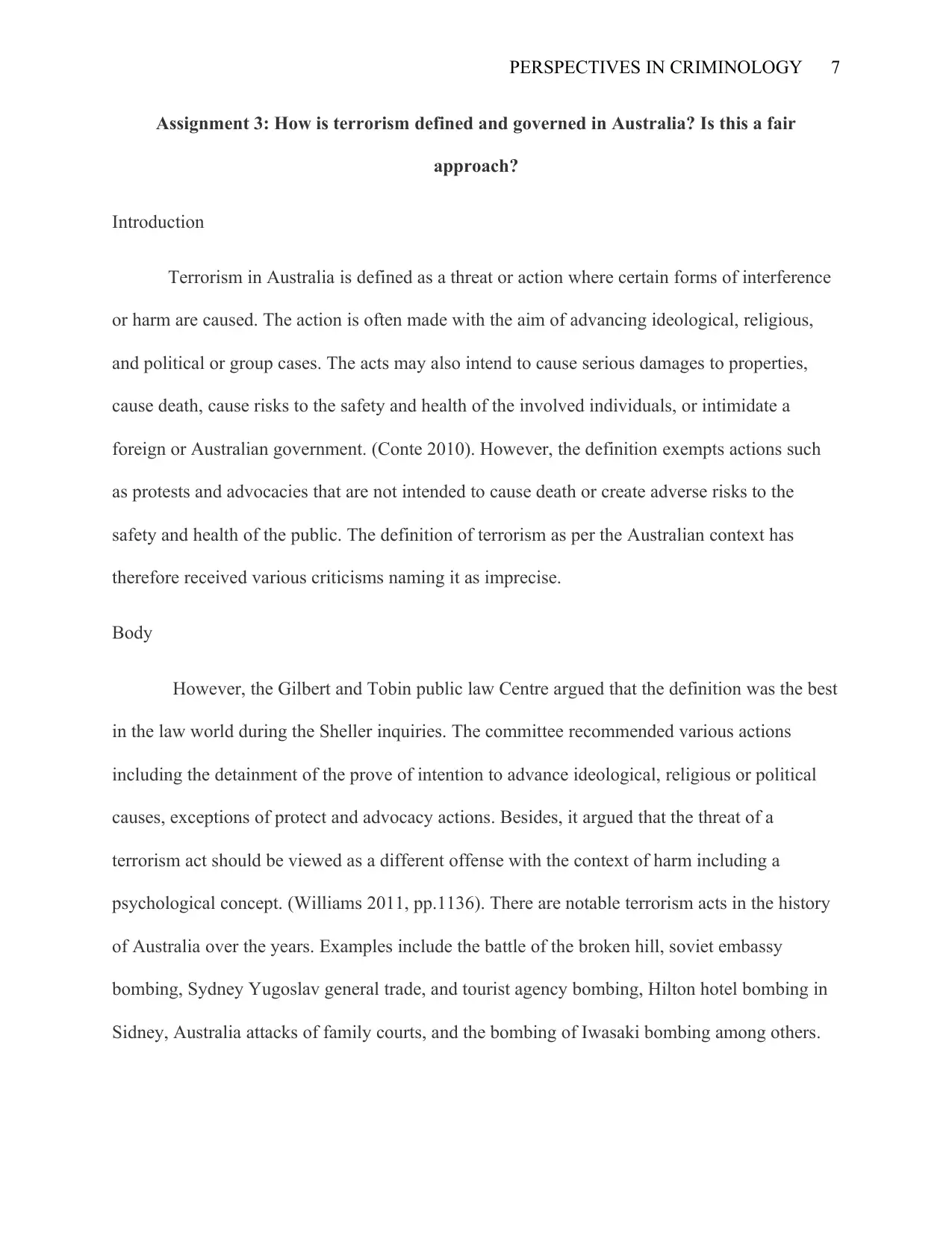
PERSPECTIVES IN CRIMINOLOGY 7
Assignment 3: How is terrorism defined and governed in Australia? Is this a fair
approach?
Introduction
Terrorism in Australia is defined as a threat or action where certain forms of interference
or harm are caused. The action is often made with the aim of advancing ideological, religious,
and political or group cases. The acts may also intend to cause serious damages to properties,
cause death, cause risks to the safety and health of the involved individuals, or intimidate a
foreign or Australian government. (Conte 2010). However, the definition exempts actions such
as protests and advocacies that are not intended to cause death or create adverse risks to the
safety and health of the public. The definition of terrorism as per the Australian context has
therefore received various criticisms naming it as imprecise.
Body
However, the Gilbert and Tobin public law Centre argued that the definition was the best
in the law world during the Sheller inquiries. The committee recommended various actions
including the detainment of the prove of intention to advance ideological, religious or political
causes, exceptions of protect and advocacy actions. Besides, it argued that the threat of a
terrorism act should be viewed as a different offense with the context of harm including a
psychological concept. (Williams 2011, pp.1136). There are notable terrorism acts in the history
of Australia over the years. Examples include the battle of the broken hill, soviet embassy
bombing, Sydney Yugoslav general trade, and tourist agency bombing, Hilton hotel bombing in
Sidney, Australia attacks of family courts, and the bombing of Iwasaki bombing among others.
Assignment 3: How is terrorism defined and governed in Australia? Is this a fair
approach?
Introduction
Terrorism in Australia is defined as a threat or action where certain forms of interference
or harm are caused. The action is often made with the aim of advancing ideological, religious,
and political or group cases. The acts may also intend to cause serious damages to properties,
cause death, cause risks to the safety and health of the involved individuals, or intimidate a
foreign or Australian government. (Conte 2010). However, the definition exempts actions such
as protests and advocacies that are not intended to cause death or create adverse risks to the
safety and health of the public. The definition of terrorism as per the Australian context has
therefore received various criticisms naming it as imprecise.
Body
However, the Gilbert and Tobin public law Centre argued that the definition was the best
in the law world during the Sheller inquiries. The committee recommended various actions
including the detainment of the prove of intention to advance ideological, religious or political
causes, exceptions of protect and advocacy actions. Besides, it argued that the threat of a
terrorism act should be viewed as a different offense with the context of harm including a
psychological concept. (Williams 2011, pp.1136). There are notable terrorism acts in the history
of Australia over the years. Examples include the battle of the broken hill, soviet embassy
bombing, Sydney Yugoslav general trade, and tourist agency bombing, Hilton hotel bombing in
Sidney, Australia attacks of family courts, and the bombing of Iwasaki bombing among others.
Paraphrase This Document
Need a fresh take? Get an instant paraphrase of this document with our AI Paraphraser
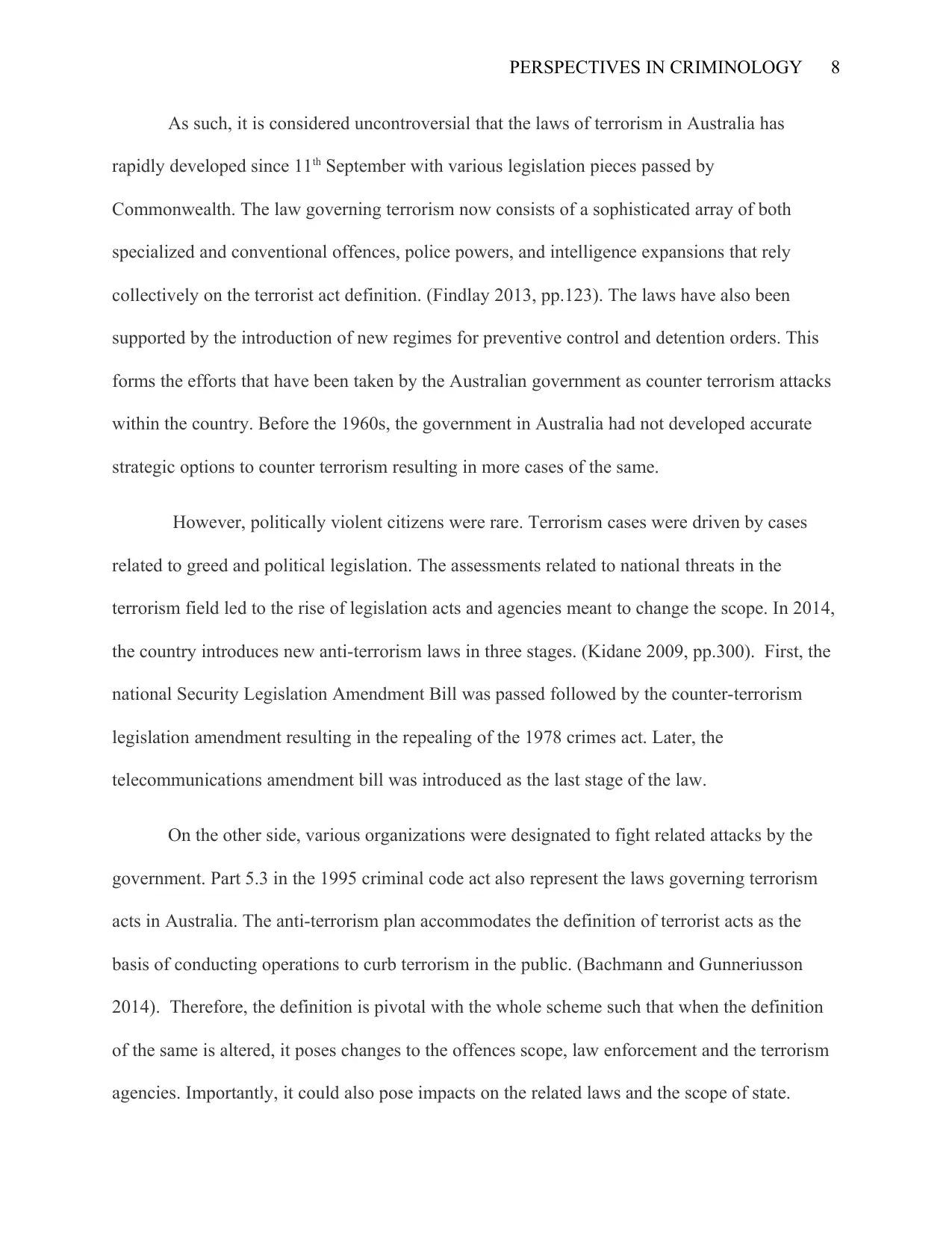
PERSPECTIVES IN CRIMINOLOGY 8
As such, it is considered uncontroversial that the laws of terrorism in Australia has
rapidly developed since 11th September with various legislation pieces passed by
Commonwealth. The law governing terrorism now consists of a sophisticated array of both
specialized and conventional offences, police powers, and intelligence expansions that rely
collectively on the terrorist act definition. (Findlay 2013, pp.123). The laws have also been
supported by the introduction of new regimes for preventive control and detention orders. This
forms the efforts that have been taken by the Australian government as counter terrorism attacks
within the country. Before the 1960s, the government in Australia had not developed accurate
strategic options to counter terrorism resulting in more cases of the same.
However, politically violent citizens were rare. Terrorism cases were driven by cases
related to greed and political legislation. The assessments related to national threats in the
terrorism field led to the rise of legislation acts and agencies meant to change the scope. In 2014,
the country introduces new anti-terrorism laws in three stages. (Kidane 2009, pp.300). First, the
national Security Legislation Amendment Bill was passed followed by the counter-terrorism
legislation amendment resulting in the repealing of the 1978 crimes act. Later, the
telecommunications amendment bill was introduced as the last stage of the law.
On the other side, various organizations were designated to fight related attacks by the
government. Part 5.3 in the 1995 criminal code act also represent the laws governing terrorism
acts in Australia. The anti-terrorism plan accommodates the definition of terrorist acts as the
basis of conducting operations to curb terrorism in the public. (Bachmann and Gunneriusson
2014). Therefore, the definition is pivotal with the whole scheme such that when the definition
of the same is altered, it poses changes to the offences scope, law enforcement and the terrorism
agencies. Importantly, it could also pose impacts on the related laws and the scope of state.
As such, it is considered uncontroversial that the laws of terrorism in Australia has
rapidly developed since 11th September with various legislation pieces passed by
Commonwealth. The law governing terrorism now consists of a sophisticated array of both
specialized and conventional offences, police powers, and intelligence expansions that rely
collectively on the terrorist act definition. (Findlay 2013, pp.123). The laws have also been
supported by the introduction of new regimes for preventive control and detention orders. This
forms the efforts that have been taken by the Australian government as counter terrorism attacks
within the country. Before the 1960s, the government in Australia had not developed accurate
strategic options to counter terrorism resulting in more cases of the same.
However, politically violent citizens were rare. Terrorism cases were driven by cases
related to greed and political legislation. The assessments related to national threats in the
terrorism field led to the rise of legislation acts and agencies meant to change the scope. In 2014,
the country introduces new anti-terrorism laws in three stages. (Kidane 2009, pp.300). First, the
national Security Legislation Amendment Bill was passed followed by the counter-terrorism
legislation amendment resulting in the repealing of the 1978 crimes act. Later, the
telecommunications amendment bill was introduced as the last stage of the law.
On the other side, various organizations were designated to fight related attacks by the
government. Part 5.3 in the 1995 criminal code act also represent the laws governing terrorism
acts in Australia. The anti-terrorism plan accommodates the definition of terrorist acts as the
basis of conducting operations to curb terrorism in the public. (Bachmann and Gunneriusson
2014). Therefore, the definition is pivotal with the whole scheme such that when the definition
of the same is altered, it poses changes to the offences scope, law enforcement and the terrorism
agencies. Importantly, it could also pose impacts on the related laws and the scope of state.
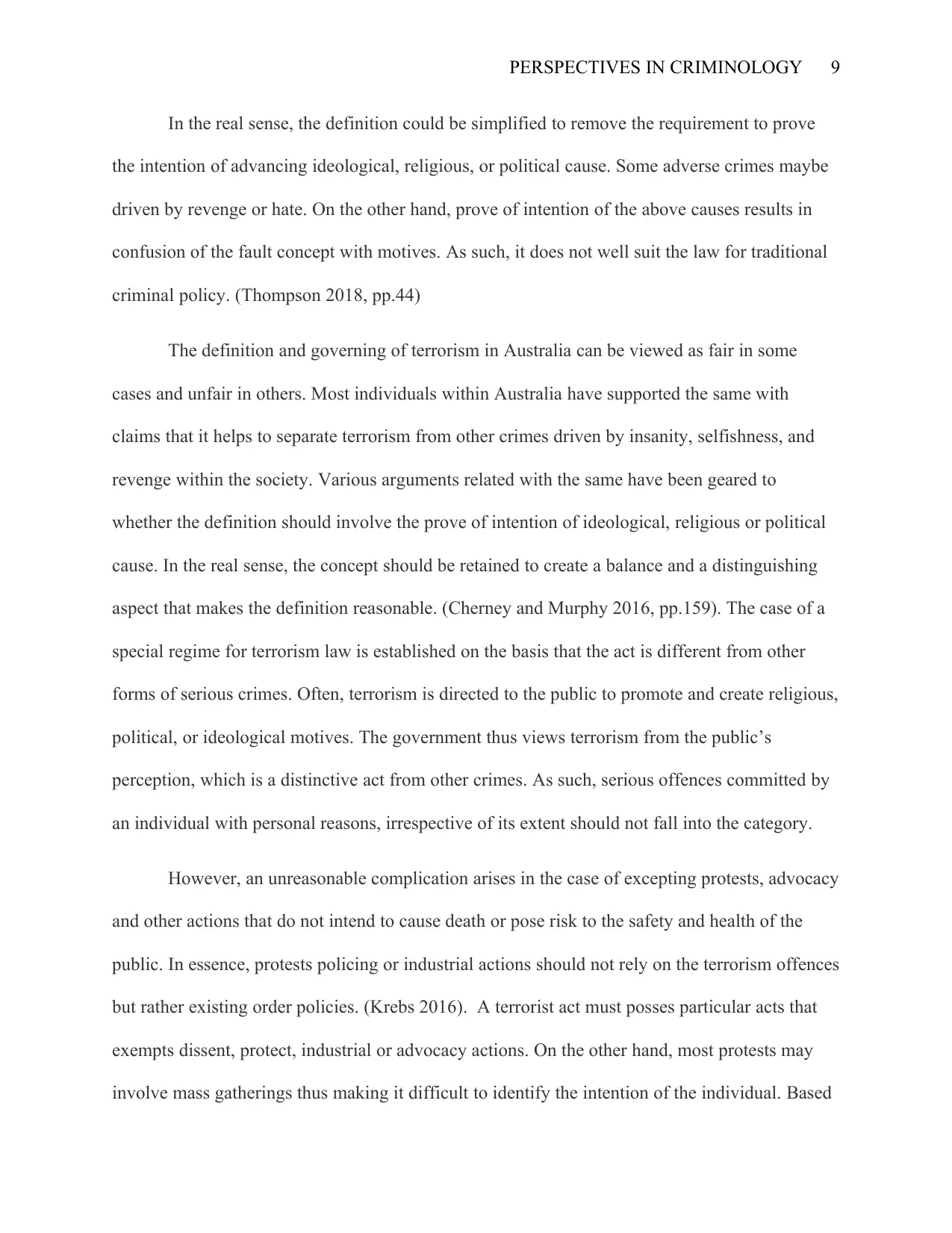
PERSPECTIVES IN CRIMINOLOGY 9
In the real sense, the definition could be simplified to remove the requirement to prove
the intention of advancing ideological, religious, or political cause. Some adverse crimes maybe
driven by revenge or hate. On the other hand, prove of intention of the above causes results in
confusion of the fault concept with motives. As such, it does not well suit the law for traditional
criminal policy. (Thompson 2018, pp.44)
The definition and governing of terrorism in Australia can be viewed as fair in some
cases and unfair in others. Most individuals within Australia have supported the same with
claims that it helps to separate terrorism from other crimes driven by insanity, selfishness, and
revenge within the society. Various arguments related with the same have been geared to
whether the definition should involve the prove of intention of ideological, religious or political
cause. In the real sense, the concept should be retained to create a balance and a distinguishing
aspect that makes the definition reasonable. (Cherney and Murphy 2016, pp.159). The case of a
special regime for terrorism law is established on the basis that the act is different from other
forms of serious crimes. Often, terrorism is directed to the public to promote and create religious,
political, or ideological motives. The government thus views terrorism from the public’s
perception, which is a distinctive act from other crimes. As such, serious offences committed by
an individual with personal reasons, irrespective of its extent should not fall into the category.
However, an unreasonable complication arises in the case of excepting protests, advocacy
and other actions that do not intend to cause death or pose risk to the safety and health of the
public. In essence, protests policing or industrial actions should not rely on the terrorism offences
but rather existing order policies. (Krebs 2016). A terrorist act must posses particular acts that
exempts dissent, protect, industrial or advocacy actions. On the other hand, most protests may
involve mass gatherings thus making it difficult to identify the intention of the individual. Based
In the real sense, the definition could be simplified to remove the requirement to prove
the intention of advancing ideological, religious, or political cause. Some adverse crimes maybe
driven by revenge or hate. On the other hand, prove of intention of the above causes results in
confusion of the fault concept with motives. As such, it does not well suit the law for traditional
criminal policy. (Thompson 2018, pp.44)
The definition and governing of terrorism in Australia can be viewed as fair in some
cases and unfair in others. Most individuals within Australia have supported the same with
claims that it helps to separate terrorism from other crimes driven by insanity, selfishness, and
revenge within the society. Various arguments related with the same have been geared to
whether the definition should involve the prove of intention of ideological, religious or political
cause. In the real sense, the concept should be retained to create a balance and a distinguishing
aspect that makes the definition reasonable. (Cherney and Murphy 2016, pp.159). The case of a
special regime for terrorism law is established on the basis that the act is different from other
forms of serious crimes. Often, terrorism is directed to the public to promote and create religious,
political, or ideological motives. The government thus views terrorism from the public’s
perception, which is a distinctive act from other crimes. As such, serious offences committed by
an individual with personal reasons, irrespective of its extent should not fall into the category.
However, an unreasonable complication arises in the case of excepting protests, advocacy
and other actions that do not intend to cause death or pose risk to the safety and health of the
public. In essence, protests policing or industrial actions should not rely on the terrorism offences
but rather existing order policies. (Krebs 2016). A terrorist act must posses particular acts that
exempts dissent, protect, industrial or advocacy actions. On the other hand, most protests may
involve mass gatherings thus making it difficult to identify the intention of the individual. Based
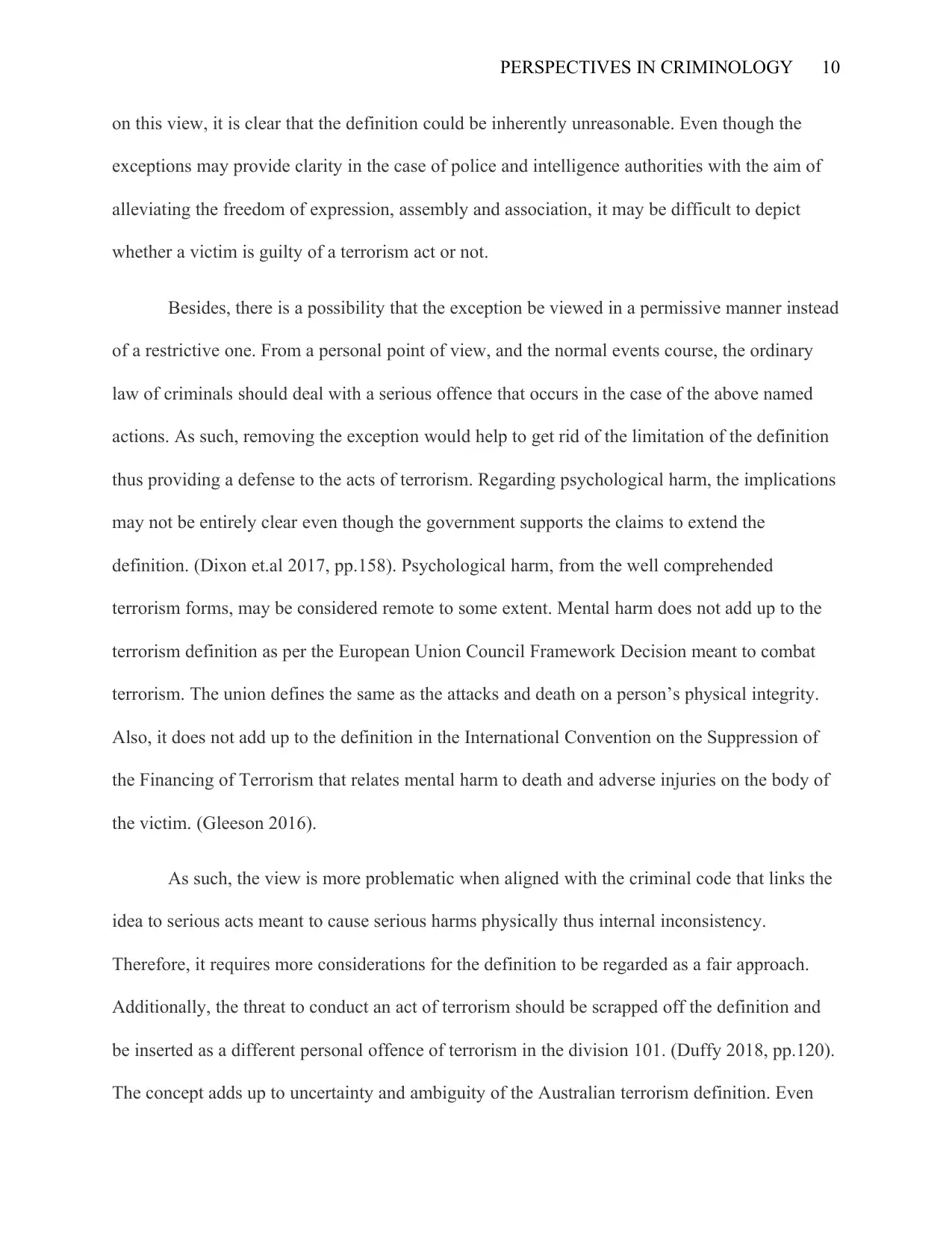
PERSPECTIVES IN CRIMINOLOGY 10
on this view, it is clear that the definition could be inherently unreasonable. Even though the
exceptions may provide clarity in the case of police and intelligence authorities with the aim of
alleviating the freedom of expression, assembly and association, it may be difficult to depict
whether a victim is guilty of a terrorism act or not.
Besides, there is a possibility that the exception be viewed in a permissive manner instead
of a restrictive one. From a personal point of view, and the normal events course, the ordinary
law of criminals should deal with a serious offence that occurs in the case of the above named
actions. As such, removing the exception would help to get rid of the limitation of the definition
thus providing a defense to the acts of terrorism. Regarding psychological harm, the implications
may not be entirely clear even though the government supports the claims to extend the
definition. (Dixon et.al 2017, pp.158). Psychological harm, from the well comprehended
terrorism forms, may be considered remote to some extent. Mental harm does not add up to the
terrorism definition as per the European Union Council Framework Decision meant to combat
terrorism. The union defines the same as the attacks and death on a person’s physical integrity.
Also, it does not add up to the definition in the International Convention on the Suppression of
the Financing of Terrorism that relates mental harm to death and adverse injuries on the body of
the victim. (Gleeson 2016).
As such, the view is more problematic when aligned with the criminal code that links the
idea to serious acts meant to cause serious harms physically thus internal inconsistency.
Therefore, it requires more considerations for the definition to be regarded as a fair approach.
Additionally, the threat to conduct an act of terrorism should be scrapped off the definition and
be inserted as a different personal offence of terrorism in the division 101. (Duffy 2018, pp.120).
The concept adds up to uncertainty and ambiguity of the Australian terrorism definition. Even
on this view, it is clear that the definition could be inherently unreasonable. Even though the
exceptions may provide clarity in the case of police and intelligence authorities with the aim of
alleviating the freedom of expression, assembly and association, it may be difficult to depict
whether a victim is guilty of a terrorism act or not.
Besides, there is a possibility that the exception be viewed in a permissive manner instead
of a restrictive one. From a personal point of view, and the normal events course, the ordinary
law of criminals should deal with a serious offence that occurs in the case of the above named
actions. As such, removing the exception would help to get rid of the limitation of the definition
thus providing a defense to the acts of terrorism. Regarding psychological harm, the implications
may not be entirely clear even though the government supports the claims to extend the
definition. (Dixon et.al 2017, pp.158). Psychological harm, from the well comprehended
terrorism forms, may be considered remote to some extent. Mental harm does not add up to the
terrorism definition as per the European Union Council Framework Decision meant to combat
terrorism. The union defines the same as the attacks and death on a person’s physical integrity.
Also, it does not add up to the definition in the International Convention on the Suppression of
the Financing of Terrorism that relates mental harm to death and adverse injuries on the body of
the victim. (Gleeson 2016).
As such, the view is more problematic when aligned with the criminal code that links the
idea to serious acts meant to cause serious harms physically thus internal inconsistency.
Therefore, it requires more considerations for the definition to be regarded as a fair approach.
Additionally, the threat to conduct an act of terrorism should be scrapped off the definition and
be inserted as a different personal offence of terrorism in the division 101. (Duffy 2018, pp.120).
The concept adds up to uncertainty and ambiguity of the Australian terrorism definition. Even
Secure Best Marks with AI Grader
Need help grading? Try our AI Grader for instant feedback on your assignments.
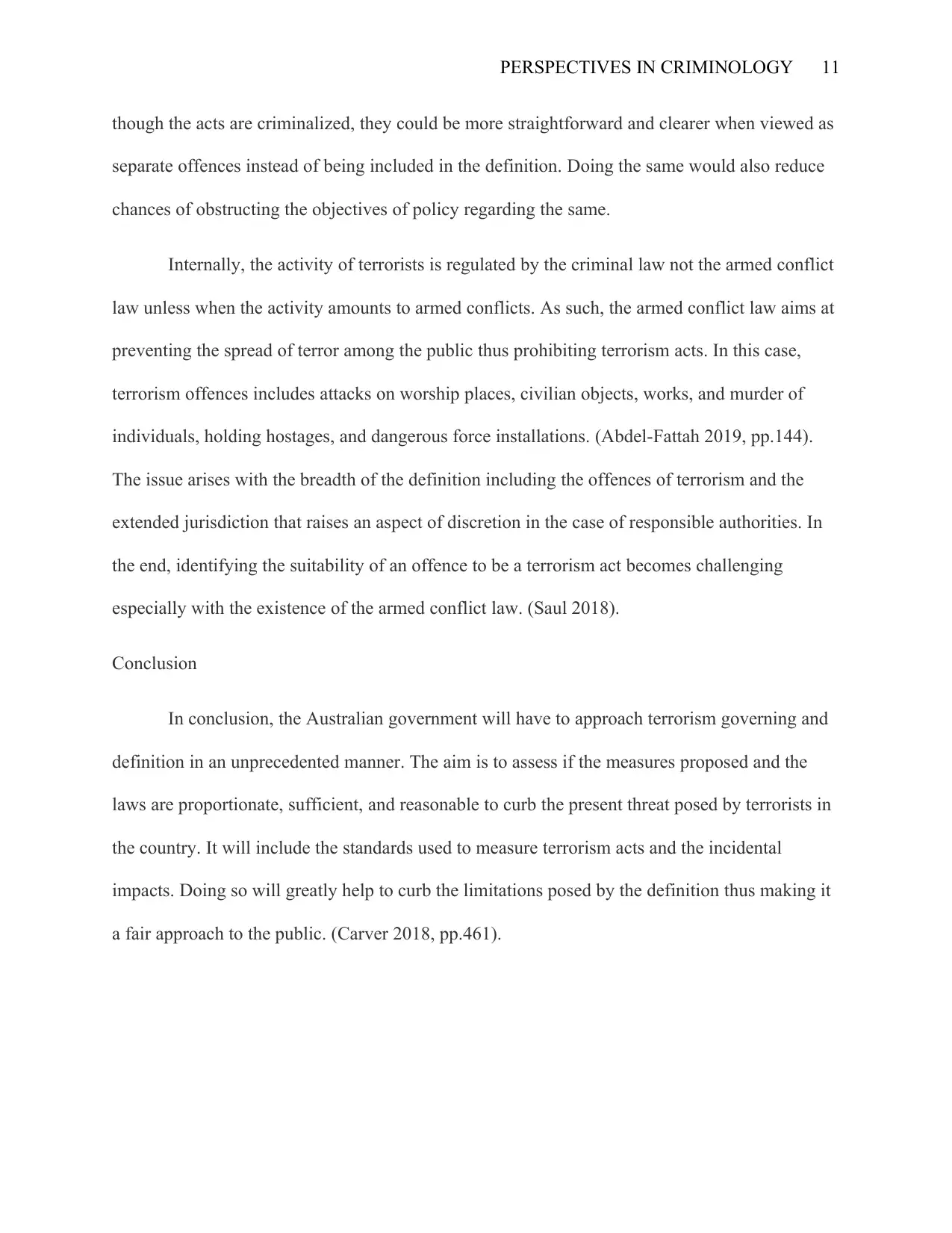
PERSPECTIVES IN CRIMINOLOGY 11
though the acts are criminalized, they could be more straightforward and clearer when viewed as
separate offences instead of being included in the definition. Doing the same would also reduce
chances of obstructing the objectives of policy regarding the same.
Internally, the activity of terrorists is regulated by the criminal law not the armed conflict
law unless when the activity amounts to armed conflicts. As such, the armed conflict law aims at
preventing the spread of terror among the public thus prohibiting terrorism acts. In this case,
terrorism offences includes attacks on worship places, civilian objects, works, and murder of
individuals, holding hostages, and dangerous force installations. (Abdel-Fattah 2019, pp.144).
The issue arises with the breadth of the definition including the offences of terrorism and the
extended jurisdiction that raises an aspect of discretion in the case of responsible authorities. In
the end, identifying the suitability of an offence to be a terrorism act becomes challenging
especially with the existence of the armed conflict law. (Saul 2018).
Conclusion
In conclusion, the Australian government will have to approach terrorism governing and
definition in an unprecedented manner. The aim is to assess if the measures proposed and the
laws are proportionate, sufficient, and reasonable to curb the present threat posed by terrorists in
the country. It will include the standards used to measure terrorism acts and the incidental
impacts. Doing so will greatly help to curb the limitations posed by the definition thus making it
a fair approach to the public. (Carver 2018, pp.461).
though the acts are criminalized, they could be more straightforward and clearer when viewed as
separate offences instead of being included in the definition. Doing the same would also reduce
chances of obstructing the objectives of policy regarding the same.
Internally, the activity of terrorists is regulated by the criminal law not the armed conflict
law unless when the activity amounts to armed conflicts. As such, the armed conflict law aims at
preventing the spread of terror among the public thus prohibiting terrorism acts. In this case,
terrorism offences includes attacks on worship places, civilian objects, works, and murder of
individuals, holding hostages, and dangerous force installations. (Abdel-Fattah 2019, pp.144).
The issue arises with the breadth of the definition including the offences of terrorism and the
extended jurisdiction that raises an aspect of discretion in the case of responsible authorities. In
the end, identifying the suitability of an offence to be a terrorism act becomes challenging
especially with the existence of the armed conflict law. (Saul 2018).
Conclusion
In conclusion, the Australian government will have to approach terrorism governing and
definition in an unprecedented manner. The aim is to assess if the measures proposed and the
laws are proportionate, sufficient, and reasonable to curb the present threat posed by terrorists in
the country. It will include the standards used to measure terrorism acts and the incidental
impacts. Doing so will greatly help to curb the limitations posed by the definition thus making it
a fair approach to the public. (Carver 2018, pp.461).
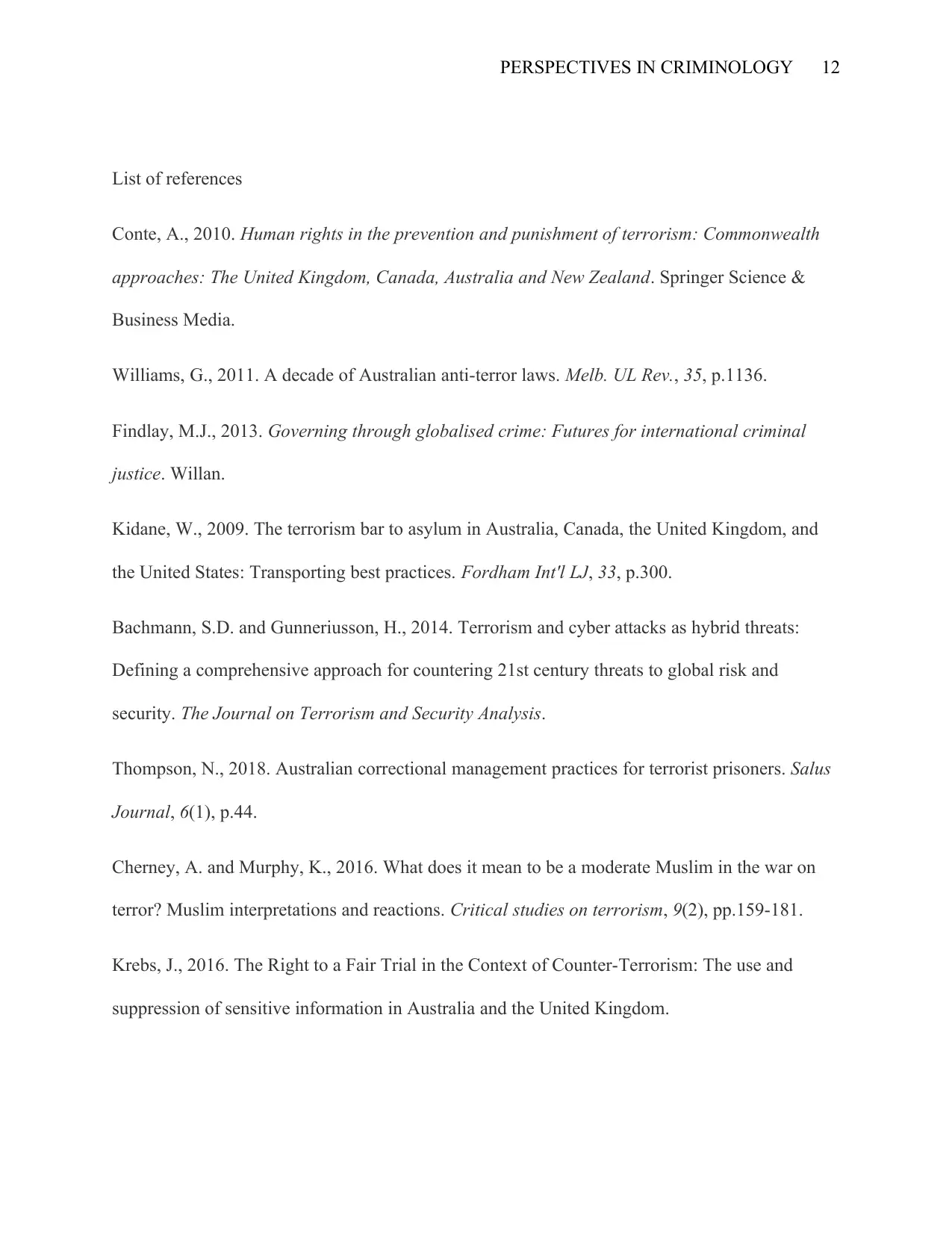
PERSPECTIVES IN CRIMINOLOGY 12
List of references
Conte, A., 2010. Human rights in the prevention and punishment of terrorism: Commonwealth
approaches: The United Kingdom, Canada, Australia and New Zealand. Springer Science &
Business Media.
Williams, G., 2011. A decade of Australian anti-terror laws. Melb. UL Rev., 35, p.1136.
Findlay, M.J., 2013. Governing through globalised crime: Futures for international criminal
justice. Willan.
Kidane, W., 2009. The terrorism bar to asylum in Australia, Canada, the United Kingdom, and
the United States: Transporting best practices. Fordham Int'l LJ, 33, p.300.
Bachmann, S.D. and Gunneriusson, H., 2014. Terrorism and cyber attacks as hybrid threats:
Defining a comprehensive approach for countering 21st century threats to global risk and
security. The Journal on Terrorism and Security Analysis.
Thompson, N., 2018. Australian correctional management practices for terrorist prisoners. Salus
Journal, 6(1), p.44.
Cherney, A. and Murphy, K., 2016. What does it mean to be a moderate Muslim in the war on
terror? Muslim interpretations and reactions. Critical studies on terrorism, 9(2), pp.159-181.
Krebs, J., 2016. The Right to a Fair Trial in the Context of Counter-Terrorism: The use and
suppression of sensitive information in Australia and the United Kingdom.
List of references
Conte, A., 2010. Human rights in the prevention and punishment of terrorism: Commonwealth
approaches: The United Kingdom, Canada, Australia and New Zealand. Springer Science &
Business Media.
Williams, G., 2011. A decade of Australian anti-terror laws. Melb. UL Rev., 35, p.1136.
Findlay, M.J., 2013. Governing through globalised crime: Futures for international criminal
justice. Willan.
Kidane, W., 2009. The terrorism bar to asylum in Australia, Canada, the United Kingdom, and
the United States: Transporting best practices. Fordham Int'l LJ, 33, p.300.
Bachmann, S.D. and Gunneriusson, H., 2014. Terrorism and cyber attacks as hybrid threats:
Defining a comprehensive approach for countering 21st century threats to global risk and
security. The Journal on Terrorism and Security Analysis.
Thompson, N., 2018. Australian correctional management practices for terrorist prisoners. Salus
Journal, 6(1), p.44.
Cherney, A. and Murphy, K., 2016. What does it mean to be a moderate Muslim in the war on
terror? Muslim interpretations and reactions. Critical studies on terrorism, 9(2), pp.159-181.
Krebs, J., 2016. The Right to a Fair Trial in the Context of Counter-Terrorism: The use and
suppression of sensitive information in Australia and the United Kingdom.
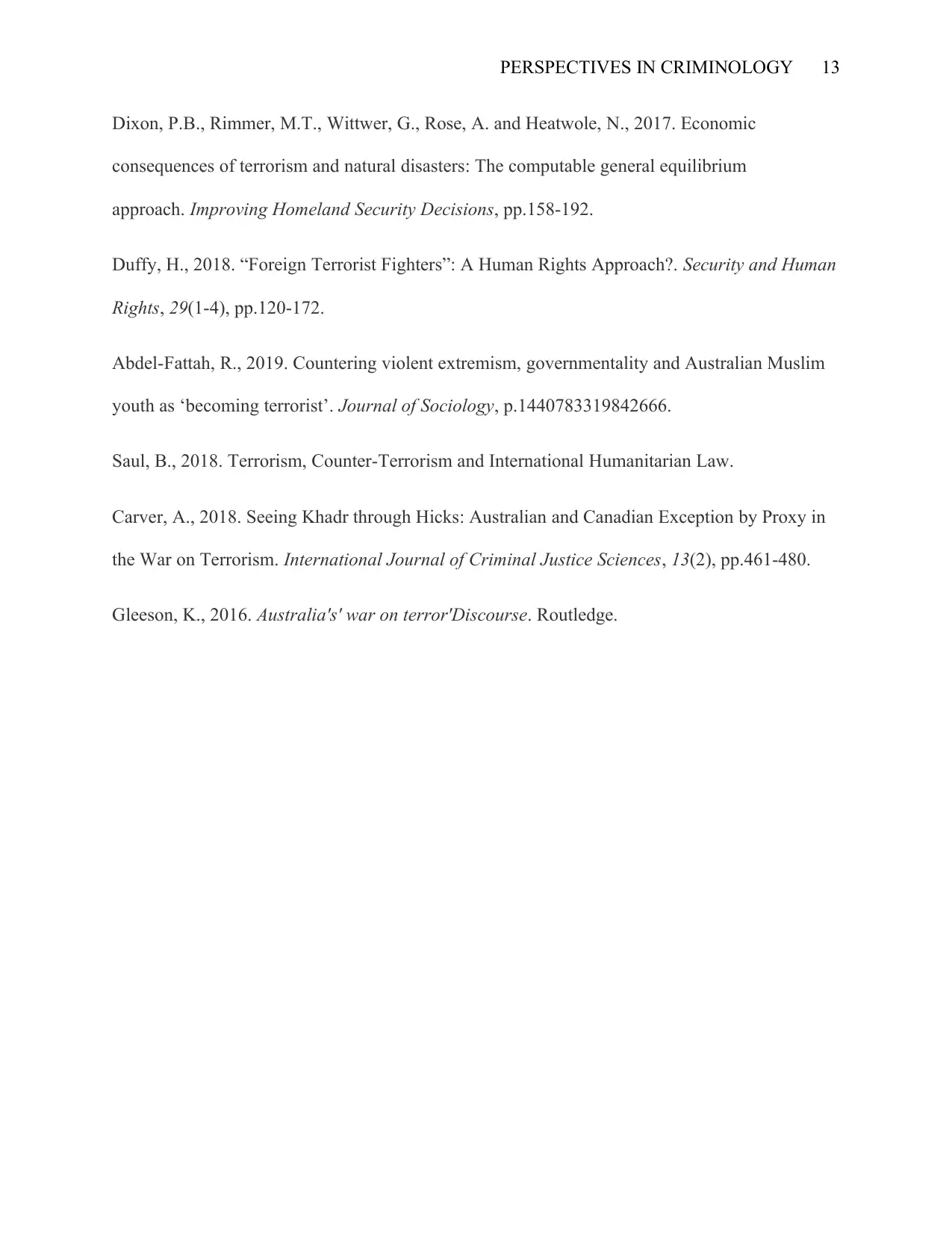
PERSPECTIVES IN CRIMINOLOGY 13
Dixon, P.B., Rimmer, M.T., Wittwer, G., Rose, A. and Heatwole, N., 2017. Economic
consequences of terrorism and natural disasters: The computable general equilibrium
approach. Improving Homeland Security Decisions, pp.158-192.
Duffy, H., 2018. “Foreign Terrorist Fighters”: A Human Rights Approach?. Security and Human
Rights, 29(1-4), pp.120-172.
Abdel-Fattah, R., 2019. Countering violent extremism, governmentality and Australian Muslim
youth as ‘becoming terrorist’. Journal of Sociology, p.1440783319842666.
Saul, B., 2018. Terrorism, Counter-Terrorism and International Humanitarian Law.
Carver, A., 2018. Seeing Khadr through Hicks: Australian and Canadian Exception by Proxy in
the War on Terrorism. International Journal of Criminal Justice Sciences, 13(2), pp.461-480.
Gleeson, K., 2016. Australia's' war on terror'Discourse. Routledge.
Dixon, P.B., Rimmer, M.T., Wittwer, G., Rose, A. and Heatwole, N., 2017. Economic
consequences of terrorism and natural disasters: The computable general equilibrium
approach. Improving Homeland Security Decisions, pp.158-192.
Duffy, H., 2018. “Foreign Terrorist Fighters”: A Human Rights Approach?. Security and Human
Rights, 29(1-4), pp.120-172.
Abdel-Fattah, R., 2019. Countering violent extremism, governmentality and Australian Muslim
youth as ‘becoming terrorist’. Journal of Sociology, p.1440783319842666.
Saul, B., 2018. Terrorism, Counter-Terrorism and International Humanitarian Law.
Carver, A., 2018. Seeing Khadr through Hicks: Australian and Canadian Exception by Proxy in
the War on Terrorism. International Journal of Criminal Justice Sciences, 13(2), pp.461-480.
Gleeson, K., 2016. Australia's' war on terror'Discourse. Routledge.
Paraphrase This Document
Need a fresh take? Get an instant paraphrase of this document with our AI Paraphraser

PERSPECTIVES IN CRIMINOLOGY 14
1 out of 14
Your All-in-One AI-Powered Toolkit for Academic Success.
+13062052269
info@desklib.com
Available 24*7 on WhatsApp / Email
![[object Object]](/_next/static/media/star-bottom.7253800d.svg)
Unlock your academic potential
© 2024 | Zucol Services PVT LTD | All rights reserved.

